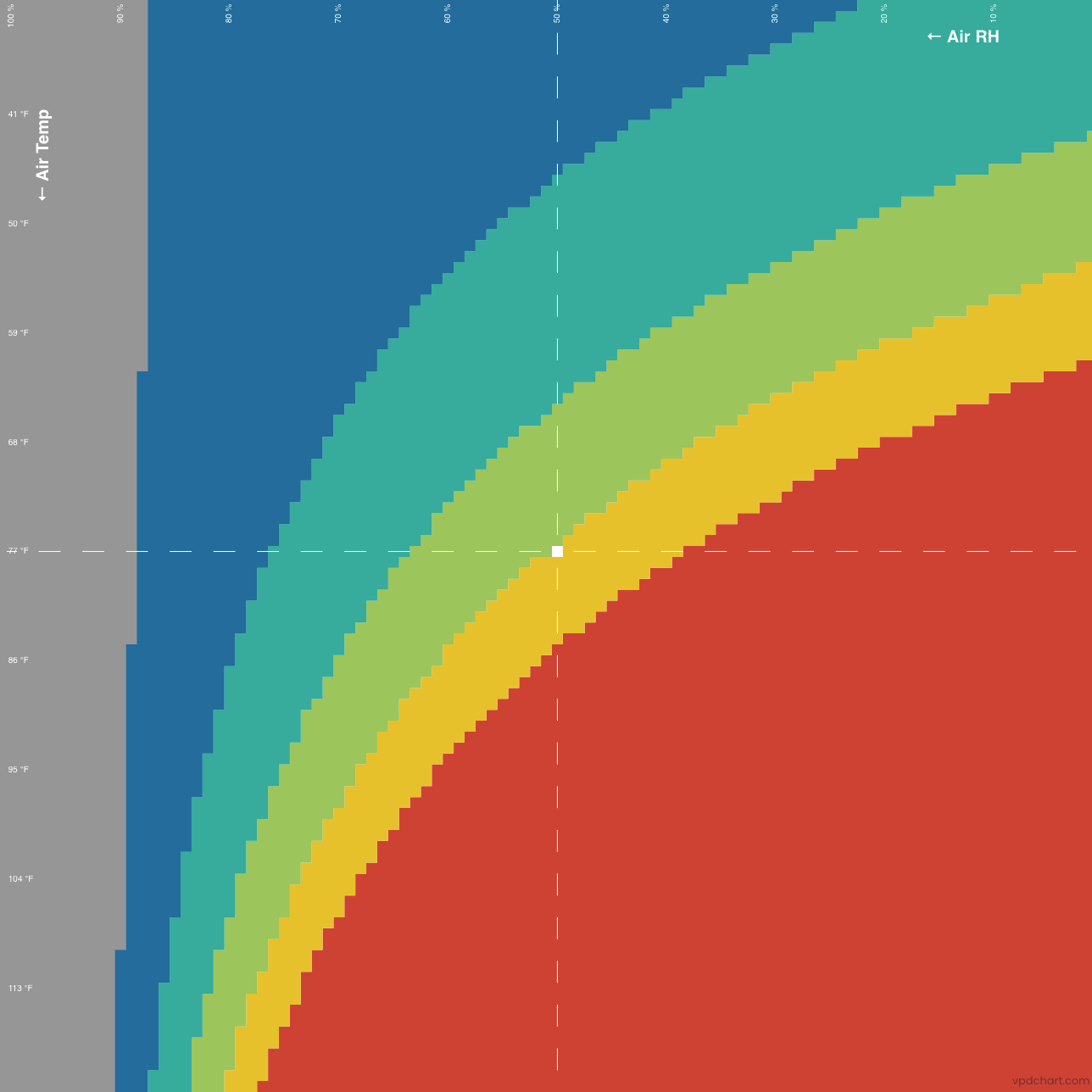Vapor Pressure Deficit is the difference in the pressure of the water in the leaf vs the pressure of the (water) vapor in the surrounding air.
For a seedling, the "optimal' VPD is 0.8, in veg it's 1.0, for flower 1.2-1.5.
How can we get our grow environment to "the right" VPD - by changing the temperature and/or RH.
The hardest thing to get your head around is that VPD is one number that define/expresses/is created by different combinations of temperature and RH (VPD also needs leaf surface temperature but I've left that out intentionally).
Check out temperatures and RH values that all result in a VPD of 1.0 in the image below. It's not just one set of temp and RH values, it's a range of temperatures and RH values.
Roll back to VPD is like the feels like temp for humans. Humans do really well in temp and RH values ranging from about 65° and 80% to 80° and 50%. Sure some folks live in more extreme ranges but I'm using these values just as an example.
It's the same thing for plants. They don't need just one temp + RH to thrive, they thrive over a range of temp+RH combinations. Fortunately, VPD allows us to use one number to "define" ("cover") all of those combinations of values.
VPD being "optimal" is a good thing to have because that allows a plant to transpire, which it needs to take up water, bringing in chemicals, and on the top side, the stomata of the leaves open, one reason being to expel water to cool the plant off.
When I started growing in 2021, I used a PulseGrow, an Inkbird controller, and a "reptile" humidifier. The Pulse could tell me the VPD and I would bump the RH value up and down on the Inkbird. Do that for one grow and you will sing praises to AC Infinity (like I did) because I was able to retire that equipment and get out of the RH controller business. The answer was the Controller 69 and their small humidifier. I've been running that for the last year and it's worked very, very well.
The C69 probe is tiny and everything updates on a one second interval. I run their app on an old iPhone (XS Mag) and on a MacBook Air and have a very high opinion of it(I've been a software engineer for 30+ years, including three for Apple.)
Why do VPD? Over the long term, you will get better outcomes.
It's especially helpful for grows where the temperature and/or RH change over the course of the day.
Pulse links to a document that says keeping VPD in range an improve yield by 20%. I don't have many more details that than because I drank the KoolAid on that along time ago and haven't looked back. If anyone's interested in learning more, the resources at their site are pretty good and their tech support is very helpful. Of course, there's other info available on the web but Pulse is the only source that I've dug into.
Pulse is moving away from the personal market and into the commercial market. Their new products came out about a year ago and it would not surprise me in the least if the new products from AC Infinity were a big driver in that change. I don't see the value proposition for a PulseGrow for the personal grower when the AC Infinity products are as extremely accurate (I calibrate the temp and RH values and they were spot on), they're very easy to use, they're cheap, and tech support is good.
</slobbering all over AC Infinity>
View attachment 5370330
 2 weeks old had them on 75% light intensity about 550 ppf for a few days then turned ir to 50% intensity yesterday which was about 450 ppf and now 25% today which is about 300. Using a 400w led which is actual draw. Watered 2 days ago in happy frog soil 25% perlite. Ph 6.2 temp about 70 humidity about 60. Do you think this was a light issue or maybe an overwatering?
2 weeks old had them on 75% light intensity about 550 ppf for a few days then turned ir to 50% intensity yesterday which was about 450 ppf and now 25% today which is about 300. Using a 400w led which is actual draw. Watered 2 days ago in happy frog soil 25% perlite. Ph 6.2 temp about 70 humidity about 60. Do you think this was a light issue or maybe an overwatering?

